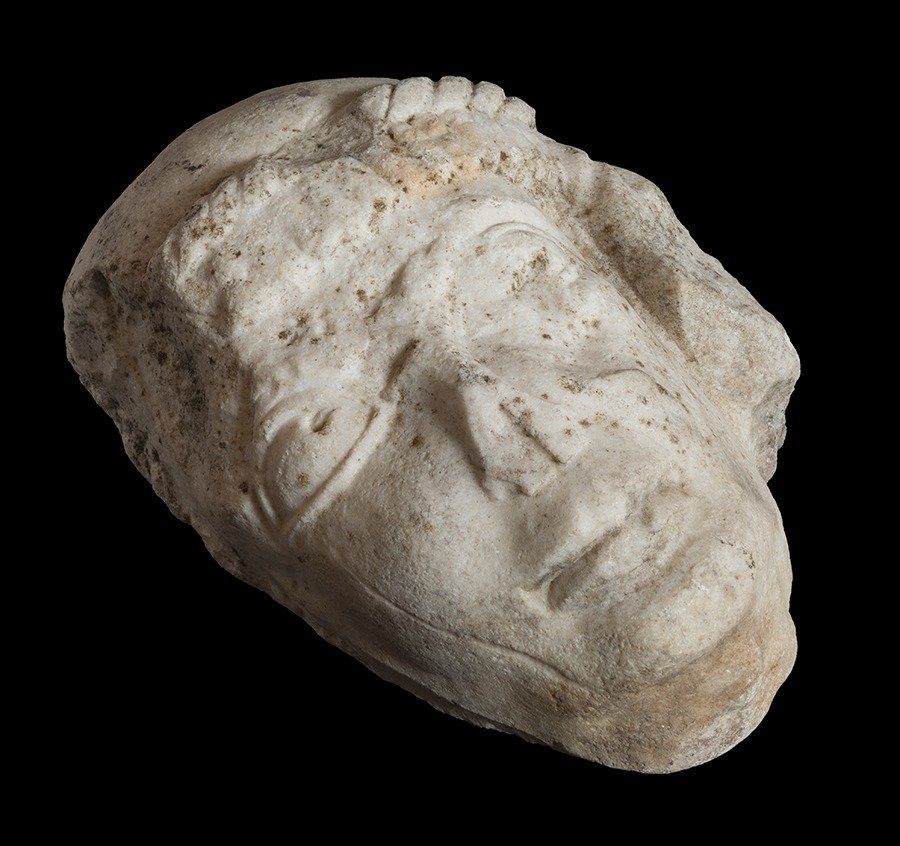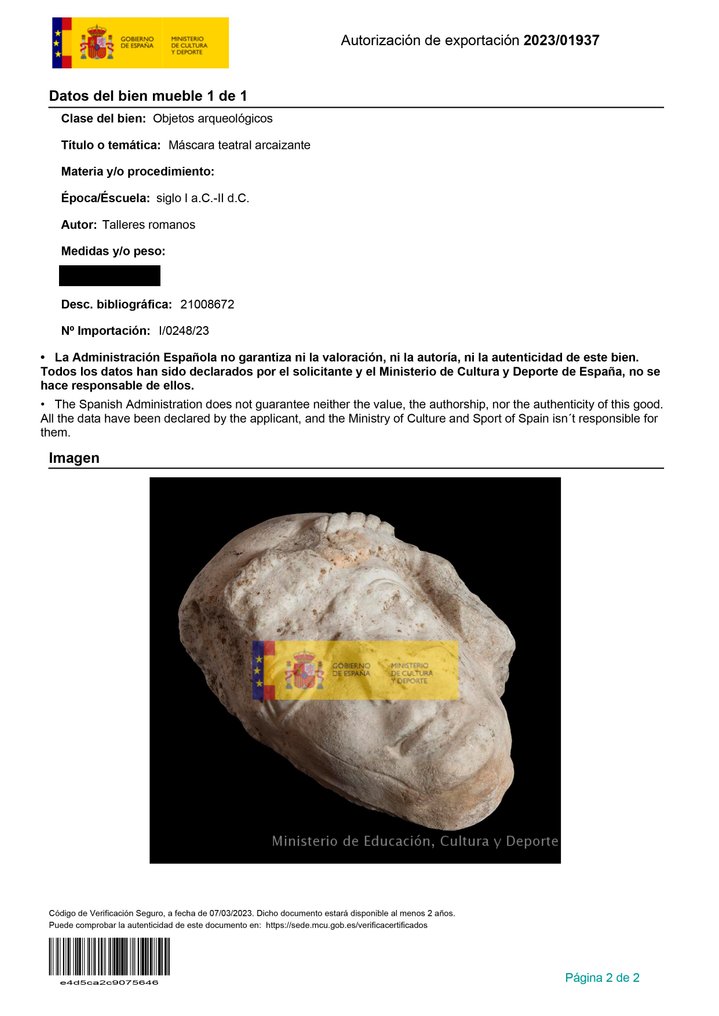Magnífica la entrega y el objeto. Perfecta la sonido del sibato
Vizualizați traducereaEpoca Romanilor Marmură masca de teatru. 29 cm H. Uriaș și Important. Licență de export spaniolă.
Nr. 87978637




theatrical mask.
Roman Empire, 1st century B.C. - 2nd century AD.
Material: Marble.
Provenance: Private Collection of Bengt Söderbergh (1925-2019), Cannes, France.
Without restorations.
Measures: 29 x 20 cm.
Theater mask with markedly archaic features, an aspect appreciable in the large almond-shaped eyes, in the hieratism of the face and in the headdress that the personage wears. The ethnologists place the birth of the mask in the moment in which the self-consciousness is produced. Its use dates back to the most distant antiquity, being found among the Egyptians, Greeks and Romans. The Greeks used them in the Dionysian festivities; the Romans during the Lupercal and Saturnalia and also in the scenic representations.
The Romans brought two important innovations to the world of sculpture: the portrait and the historical relief, neither of which existed in the Greek world. However, they followed the Greek models for a large part of their sculptural production, a base that in Rome was combined with the Etruscan tradition. After the first contacts with the Greece of classicism through the colonies of Magna Graecia, the Romans conquered Syracuse in 212 BC, a rich and important Greek colony located in Sicily, adorned with a large number of Hellenistic works. The city was sacked and its artistic treasures taken to Rome, where the new style of these works soon replaced the Etruscan-Roman tradition that had prevailed until then. Cato himself denounced the sacking and decoration of Rome with Hellenistic works, which he considered a dangerous influence on native culture, and deplored the Romans' applauding of statues from Corinth and Athens, while ridiculing the decorative terracotta tradition of ancient Roman temples. However, these oppositional reactions were in vain; Greek art had subdued Etruscan-Roman art in general, to the point that Greek statues were among the most coveted prizes of war, being displayed during the triumphal procession of the conquering generals.
NOTES:
- The piece includes authenticity certificate.
- The piece includes Spanish Export License.
- The seller guarantees that he acquired this piece according to all national and international laws related to the ownership of cultural property. Provenance statement seen by Catawiki.
THE MINISTRY OF CULTURE FROM SPAIN ASKS ALL SELLERS FOR INVOICES OR OTHER DOCUMENTATION ABLE TO PROVE THE LEGALITY OF EACH ITEM BEFORE PROVIDING AN IMPORT OR EXPORT LICENSE.
#ancientolympics
Povestea Vânzătorului
theatrical mask.
Roman Empire, 1st century B.C. - 2nd century AD.
Material: Marble.
Provenance: Private Collection of Bengt Söderbergh (1925-2019), Cannes, France.
Without restorations.
Measures: 29 x 20 cm.
Theater mask with markedly archaic features, an aspect appreciable in the large almond-shaped eyes, in the hieratism of the face and in the headdress that the personage wears. The ethnologists place the birth of the mask in the moment in which the self-consciousness is produced. Its use dates back to the most distant antiquity, being found among the Egyptians, Greeks and Romans. The Greeks used them in the Dionysian festivities; the Romans during the Lupercal and Saturnalia and also in the scenic representations.
The Romans brought two important innovations to the world of sculpture: the portrait and the historical relief, neither of which existed in the Greek world. However, they followed the Greek models for a large part of their sculptural production, a base that in Rome was combined with the Etruscan tradition. After the first contacts with the Greece of classicism through the colonies of Magna Graecia, the Romans conquered Syracuse in 212 BC, a rich and important Greek colony located in Sicily, adorned with a large number of Hellenistic works. The city was sacked and its artistic treasures taken to Rome, where the new style of these works soon replaced the Etruscan-Roman tradition that had prevailed until then. Cato himself denounced the sacking and decoration of Rome with Hellenistic works, which he considered a dangerous influence on native culture, and deplored the Romans' applauding of statues from Corinth and Athens, while ridiculing the decorative terracotta tradition of ancient Roman temples. However, these oppositional reactions were in vain; Greek art had subdued Etruscan-Roman art in general, to the point that Greek statues were among the most coveted prizes of war, being displayed during the triumphal procession of the conquering generals.
NOTES:
- The piece includes authenticity certificate.
- The piece includes Spanish Export License.
- The seller guarantees that he acquired this piece according to all national and international laws related to the ownership of cultural property. Provenance statement seen by Catawiki.
THE MINISTRY OF CULTURE FROM SPAIN ASKS ALL SELLERS FOR INVOICES OR OTHER DOCUMENTATION ABLE TO PROVE THE LEGALITY OF EACH ITEM BEFORE PROVIDING AN IMPORT OR EXPORT LICENSE.
#ancientolympics
Povestea Vânzătorului
- 825
- 10
- 1
very well packed with all the documents included, thnks
Vizualizați traducereaGreat object. Really beautiful. Quick delivery. Excellent.
Vizualizați traducereaSuperbe objet, Service d'Arqueologia Ancient Art excellent et rapide. Jaume Bagot toujours parfait .
Vizualizați traducereaTodo perfecto gracias
Vizualizați traducereaNice item all ok A+++
Vizualizați traducereaThank you for this Oinochoe, one question: did you as promised read my post!
Vizualizați traducereaVery cooperative in every aspect of the transaction.
Vizualizați traducereaAlways a great pleasure!
Vizualizați traducereaFine quality, good service. Thanks.
Vizualizați traducereaMuy amables, muy bien todo. Gracias
Vizualizați traducereaAlles bestens
Vizualizați traducereaexactly as described and shipped safely and punctually.
Vizualizați traducereaschnelle Lieferung sehr sichere Verpackung alles bestens
Vizualizați traducereatres bel objet je le recherchai depuis longtemps envoi rapide et protégé je pense qu'il y aura d'autres achats avec ce vendeur merci +++++++
Vizualizați traducereaEinfach nur toll
Vizualizați traducereaTodo perfecto
Vizualizați traducereaottimo
Vizualizați traducereaperfetto
Vizualizați traducereatop oggetto bellissimo grazie 💯💯💯💯💯💯 :-)
Vizualizați traducereaI bought this beautiful artifact together with artifact from Mr. Bagot but although it is clearly stated on his shipping page that when purchasing multiple artifacts i paid the double package costs
Vizualizați traducereaI bought this beautiful artifact together with artifact from Mr. Bagot but although it is clearly stated on his shipping page that when purchasing multiple artifacts i paid the double package costs
Vizualizați traducereaBel objet, bien emballé. Parfait.
Vizualizați traducereawonderful faiece and very fast shipping.thanks a lot
Vizualizați traducereaJ Bagot es un profesional excelente. Sus artículos son de gran calidad, se incluye la documentación necesaria y el embalaje se realiza con esmero. Le recomiendo encarecidamente.
Vizualizați traducerea- 825
- 10
- 1
Magnífica la entrega y el objeto. Perfecta la sonido del sibato
Vizualizați traducereaDeclinarea responsabilității
Vânzătorul garantează și poate dovedi că obiectul a fost obținut în mod legal. Vânzătorul a fost informat de către Catawiki că trebuie să furnizeze documentația cerută de legile și reglementările din țara de reședință. Vânzătorul garantează și are dreptul de a vinde/exporta acest obiect. Vânzătorul va furniza cumpărătorului toate informațiile disponibile cu privire la proveniența obiectului. Vânzătorul se asigură că toate autorizațiile necesare sunt/vor fi puse la punct. Vânzătorul va informa imediat cumpărătorul cu privire la eventualele întârzieri în obținerea unor astfel de autorizații.
Vânzătorul garantează și poate dovedi că obiectul a fost obținut în mod legal. Vânzătorul a fost informat de către Catawiki că trebuie să furnizeze documentația cerută de legile și reglementările din țara de reședință. Vânzătorul garantează și are dreptul de a vinde/exporta acest obiect. Vânzătorul va furniza cumpărătorului toate informațiile disponibile cu privire la proveniența obiectului. Vânzătorul se asigură că toate autorizațiile necesare sunt/vor fi puse la punct. Vânzătorul va informa imediat cumpărătorul cu privire la eventualele întârzieri în obținerea unor astfel de autorizații.









